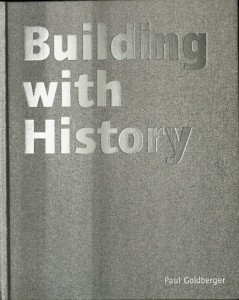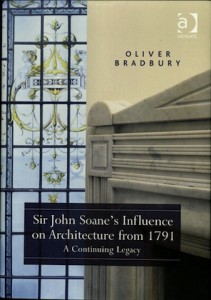The three new books highlighted below all approach history through slightly different lenses: an architect’s engagement with history in his current practice; the legacy of one architect’s work on succeeding generations; and the preservation of the built fabric.
Goldberger, Paul. Building with History. Forward by Norman Foster. Photographs by Richard Bryant and Mark Fiennes. Munich: Prestel, 2014.
Building with History examines seventeen projects by Norman Foster  that explore the relationship between old and new. The work consists of an essay, “Building with History,” by Paul Goldberg, a photo essay by Richard Bryant and Mark Fiennes, and finally, the Project Portfolio which includes the plans and drawings of the included works. Goldberger concludes his essay:
that explore the relationship between old and new. The work consists of an essay, “Building with History,” by Paul Goldberg, a photo essay by Richard Bryant and Mark Fiennes, and finally, the Project Portfolio which includes the plans and drawings of the included works. Goldberger concludes his essay:
The presence and visibility of this [temporal] arc makes each of these works of architecture and civic space a living and changing thing, not an object frozen outside of time. In every project examined here, while the new would not have been brought into existence without the old, the old would have an entirely different existence – and a vastly diminished meaning – without a contemporary intervention beside it to provide the architecture of the past with constant challenge, protection and resonance. (Goldberger, 57)
Bradbury, Oliver. Sir John Soane’s Influence on Architecture from 1791: A Continuing Legacy. Burlington, VT: Ashgate Publishing Compnay, 2015.
Oliver Bradbury’s work is a collection of four essays arranged chronologically that examine the influence of John Soane (1753-1837) from 1791 through Modernism. Bradbury’s guiding thesis is as follows:
(1753-1837) from 1791 through Modernism. Bradbury’s guiding thesis is as follows:
A Continuing Legacy features the work of famous architects such as Benjamin Henry Latrobe and Philip Johnson, as well as many not-so-well-known Soanean disciples, in the process arguing that Soane has been almost continuously influential for more than two hundred years… (Bradbury, Preface)
Longstreth, Richard. Looking Beyond the Icons: Midcentury Architecture, Landscape and Urbanism. Charlottesville, VA: University of Virginia Press, 2015.
Longstreth’s new publication consists of a series of previously published but updated material alongside the presentation of eight  case studies which include the visitor center at Gettysburg, Broughton Street in Savannah, and St. Francis Cabrini in New Orleans. Longstreth states:
case studies which include the visitor center at Gettysburg, Broughton Street in Savannah, and St. Francis Cabrini in New Orleans. Longstreth states:
The intent of all these case studies is to underscore how addressing historical significance, even for seemingly simple things, is not a simple process conceptually. Equally important is to emphasize how the nature of inquiry- the questions asked, the sources pursued, and ultimately the matters addressed- can vary to a considerable degree from case to case, demanding assessment predicated on the individual circumstances rather than on formulaic assumptions. The basic methods of inquiry are no different for the mid-twentieth century than for any other era, but the particulars of inquiry must be attuned to the particulars at hand, irrespective of period. (Longstreth, 5)
